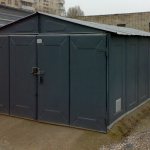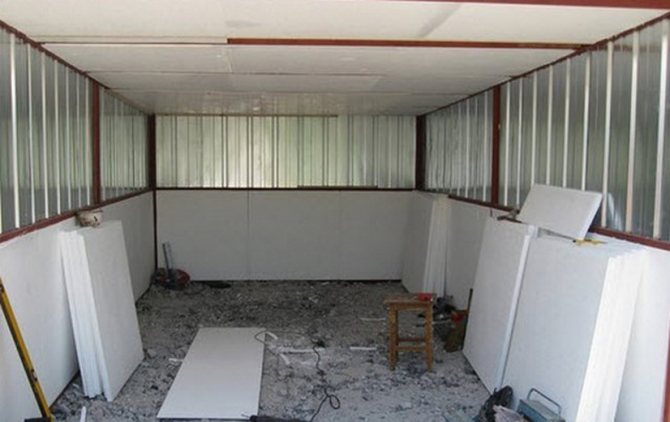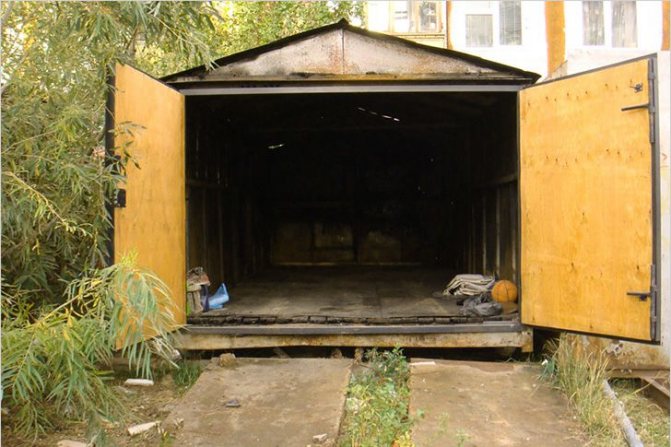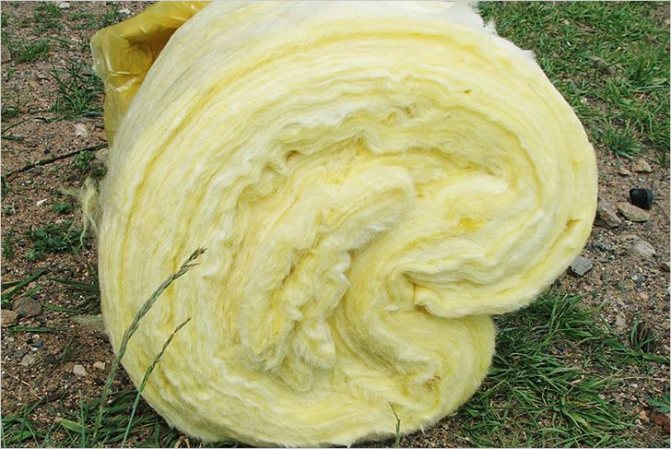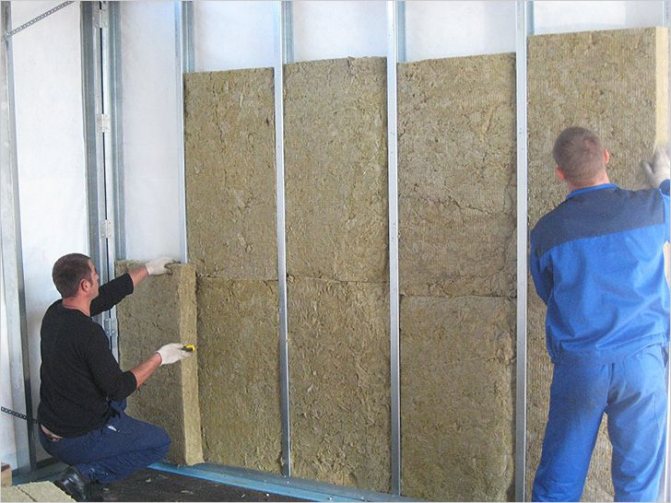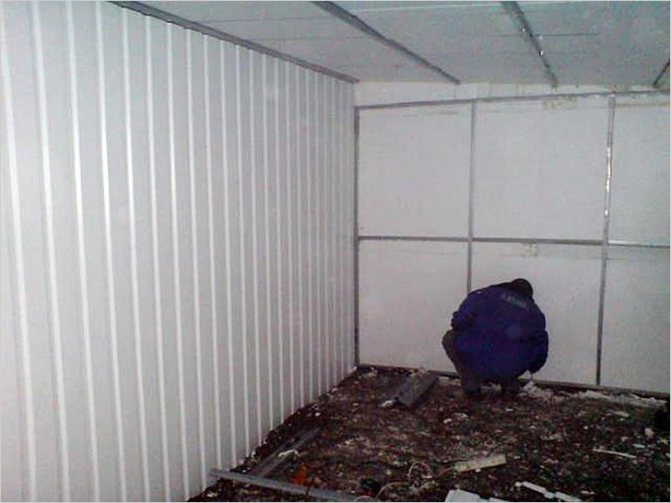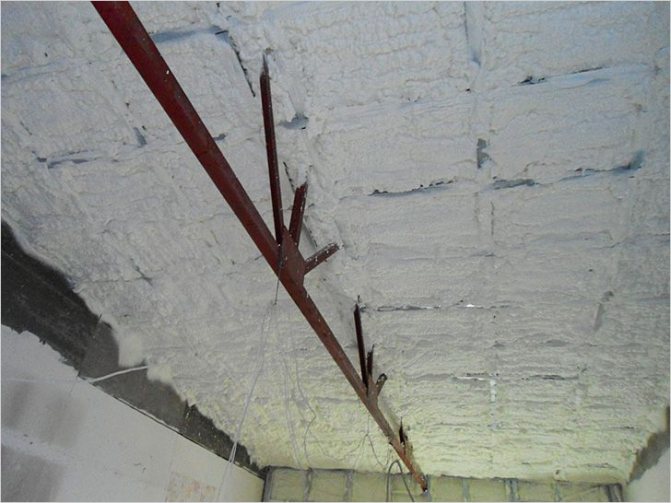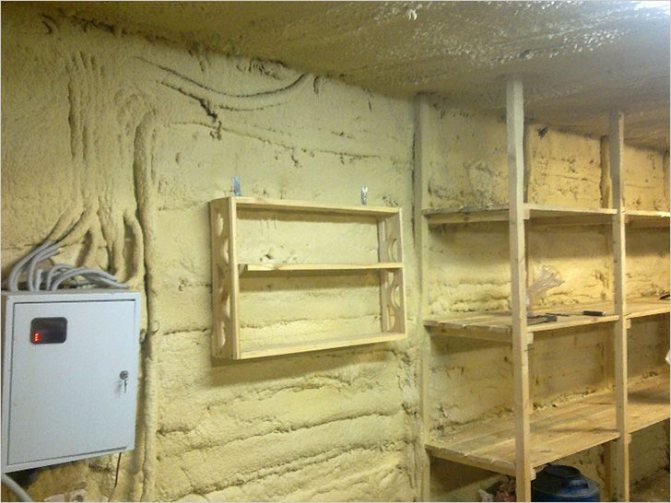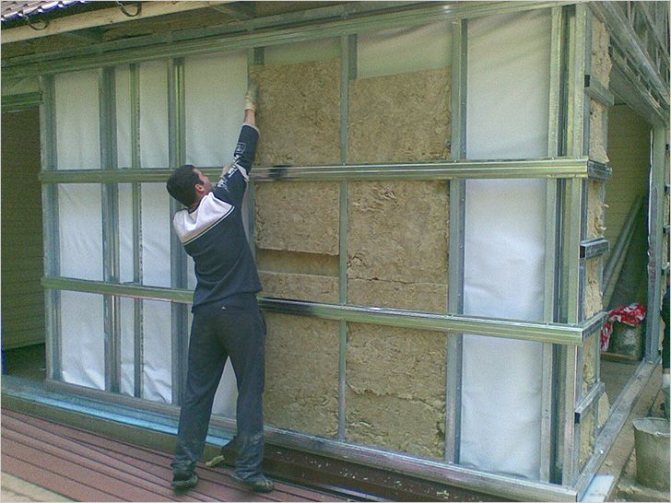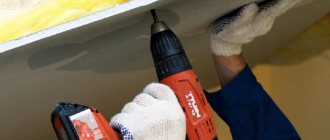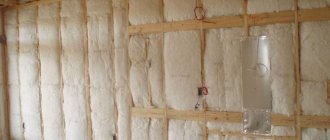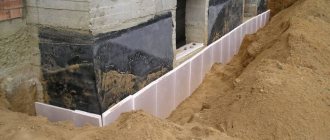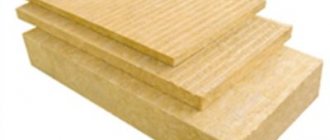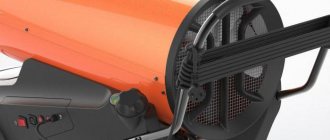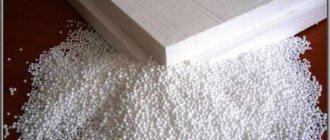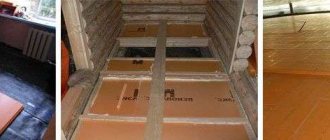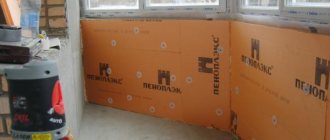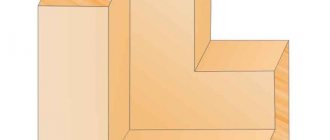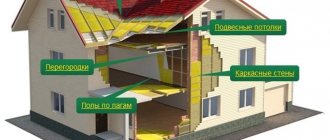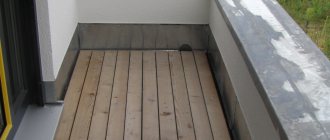A metal garage is the easiest way to hide a car from bad weather and intruders. Naturally, it is necessary to make it warm in order to make it comfortable to stay in the "stall" of your favorite vehicle. How to insulate an ordinary metal unheated garage? Now it is customary to carry out insulation with classical materials. Although the construction market is ready to offer a lot of new products that have excellent characteristics in terms of thermal insulation. Therefore, the problem of insulating a metal garage is easy to solve. But how to do it correctly, how to carry out insulation - we will analyze in more detail.
Materials (edit)
Advanced motorists who decide to insulate the garage with their own hands prefer to use the following insulator options as material:
- Polyurethane foam. Special equipment is required to apply polyurethane foam to the surface. However, only such material allows for really high-quality insulation, and for many decades. This is the best way to get things done.
- Penoizol. This is the name of liquid foam. It is also durable, it is not afraid of moisture, high temperature.
- Astratek. Another liquid heat insulator applied by a brush. A millimeter layer of Astratek retains as much heat as thick mineral wool. Disadvantage: high consumption (about half a liter per square meter of metal).
Each of the listed materials for garage insulation is quite effective, but usually the owner of the car is forced to abandon it due to its high cost. Therefore, much more often a metal garage is insulated using the most affordable material, namely, foam.
Insulation from the inside
The walls of a metal garage are best insulated from the inside. The production of work in this case is carried out in a certain sequence.
Frame device
A frame is a structure designed for mounting heat-insulating material on walls. Before proceeding with the insulation of the garage with your own hands, you must:
- prepare surfaces, clean walls;
- to make a false partition from drywall, on the frame of which the heat-insulating material will be attached.
For the manufacture of the frame, wall-mounted CD-profiles and UD-guides are used. Installation of UD-racks to the floor and ceiling is carried out using dowels with a pitch of 0.25-0.3 meters. CD-profiles should be installed using special hangers with a pitch of 0.6 meters.
The hangers used for installation are fixed in the wall every 30 centimeters.
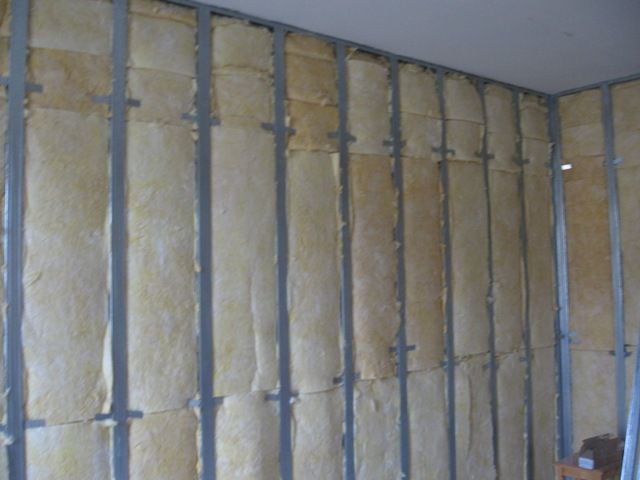
It is to them that drywall is attached, which is a facing layer.
Insulation of the walls of a metal garage
Consider how to insulate a metal garage from the inside, and completely with your own hands. All work is required to be performed according to a certain scheme. First, it is necessary to make a frame, inside which the insulator plates will then be laid.
To begin with, you should take care of the availability of a certain tool. It is impossible to do in such a matter as insulating your own garage, without a drill, screwdriver, hacksaw, grinder. When everything is collected that is necessary, you can start the process of warming.
First, you need to mount the frame from the guides and profile, using the material that is taken for the manufacture of plasterboard partitions. The guides are fastened with dowels, and the profile is fixed to them with special hangers.
After the garage insulation, it is not necessary to use drywall for cladding thermal insulation; asbestos fiber is also suitable for this purpose. The material perfectly resists fire, but is fragile. Because of this, the distance between the posts is required to be slightly less.
After completing the installation of the frame, insulation should be placed between the racks. We recommend using a classic heat insulator - glass wool or mineral wool slabs. This material retains heat well, it is non-flammable. But the cheaper option - polystyrene, refers to flammable substances that release toxic components when ignited. If the step between the posts is made across the width of the mineral slabs, their installation will be simple and will not require additional adjustment. The final stage of insulation is the fixing of the vapor barrier material with tape and the installation of the cladding.
The cheapest material that allows you to insulate the walls of a metal garage from the inside is foam. Before using glue to fix this material, it is necessary to thoroughly clean the inner surfaces of the building from rust and the slightest dirt, then by all means degrease the metal. So the mount will be of better quality. When the foam sheets are already glued, it is advisable to blow out the gaps between them from a can of polyurethane foam. Then you can close the insulation layer with any finishing material.
Installation work
Since, according to the laws of physics, heat always leaves through the top, the insulation of a metal garage should be started from the ceiling. There are a lot of options for finishing it, in particular, it is quite possible
Ceiling
on the organization of a "false ceiling". However, this will somewhat reduce the usable area of the room.
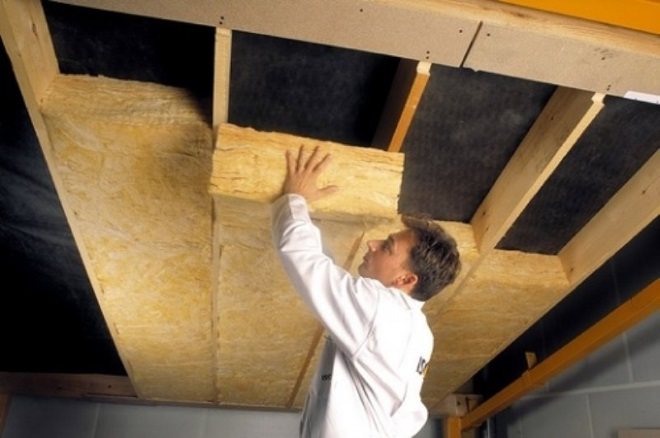

Ceiling insulation
Also, for protection, layers of mineral wool are suitable, which should be mounted by means of a crate. In this case, it is better to use an angle profile, bituminous mastic and a special sealant. It should be noted here that experts do not welcome this method due to its technical complexity.
In addition, liquid insulation is suitable for these purposes, whether it be foam insulation or polyurethane foam.
Walls
The type of installation work will depend on the choice of heaters. So, for the installation of thermal insulation by means of glass or mineral wool, as well as foam, you will need a crate made of wooden slats or metal profiles. The width of its gaps should correspond to the parameters of the layers of the selected insulation. Do not forget about the need to lay a waterproofing film between the surface of the walls, insulation and cladding. It should be understood that insulating a garage with foam requires a layer of heat insulator of at least 3-4 cm.
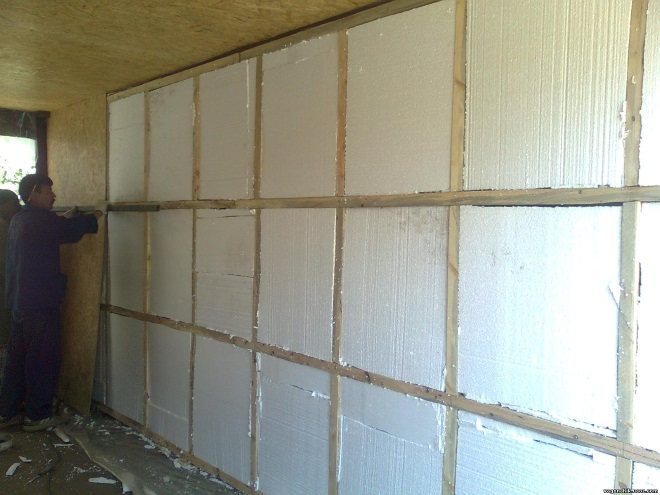

Wall insulation with foam
If some thin insulation is used as a finish, then an adhesive can be used to apply it. And such a heat insulator like polyurethane foam will independently close all seams and irregularities, since it will cover the surface with a strong crust. However, its application requires special tools, therefore it is recommended to contact professionals to perform such work.
If the choice of the owner fell on heat-insulating paint, then a roller is indispensable. Before purchasing the substance, it will be necessary to carry out certain calculations, since the consumption looks impressive - about half a liter per 1 m2.
Goal
So, you already know about how to insulate a metal garage from the inside. But there is one more thing to remember. Namely - about the insulation of the gate, through the cracks of which all the heat evaporates. If in temperate latitudes, in order to reduce heat loss when leaving the garage, it is enough to make a cloth curtain of dense fabric, then in cold regions one cannot do without insulating the gate with insulating sheathing.
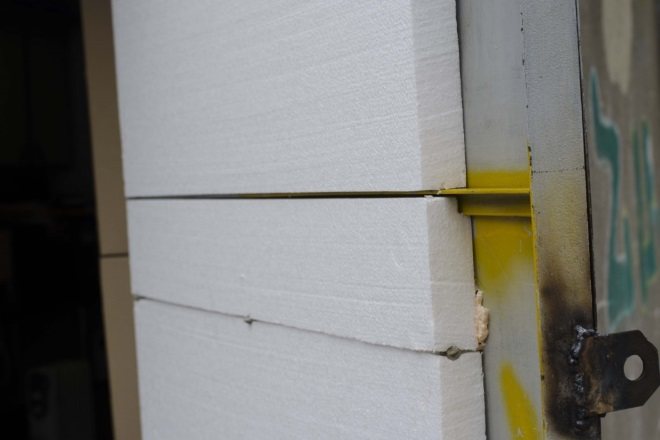

Insulation of the gate with foam
For these purposes, foam is perfect, due to the ease of its installation. Or hard insulation - expanded polystyrene. It is cut into slabs of a given size, after which it is attached to wooden planks, which were prudently stuffed onto the gate. Just before that, the iron surface must be covered with a waterproofing film, and the wooden slats - with anti-mold mastic. Fastening takes place by means of an adhesive. You should not forget to treat the seams with a sealant, and install a rubber gasket along the walls so that the cold does not blow out. Then you can start finishing the insulated surface with some kind of moisture-resistant material. The drain under the gate in winter is plugged with thick rags.
It is also recommended to carry out insulation work outside. This will allow you to achieve maximum efficiency and comfortable pastime in the equipped space.
Insulation of the gate of a metal garage
Having decided to make the insulation of a metal garage of high quality, you should make sure that the gates do not let cold into the room either. Experienced motorists recommend making an entrance door in the gate leaf, then you don't have to open them completely at the entrance. In addition, a special curtain should be arranged from the inside in front of the gate to prevent heat leakage from the room.
An excellent material for organizing the task at hand is transparent plastic or plastic wrap (always thick). Having cut the selected version of the protective curtain into long strips, they are attached with a stapler to a wooden rail fixed above the gate from the inside. Each fixed strip must find one and a half centimeters on its neighbor, then when the car leaves, they will deflect and then return back, preventing heat from escaping.
However, the curtain alone is not enough; the door leaf itself must also be insulated with a protective material. Typically, foam is used for this purpose, which can be fixed to the metal using glue.
You can sheathe polystyrene outside with anything:
- clapboard;
- plywood;
- Fiberboard;
- plastic.
To prevent the penetration of cold through the gaps around the perimeter of the gate, use a rubber seal. So that condensation does not subsequently appear, it is advisable to treat the metal at the place where the rubber is glued with any anti-corrosion compound.
Types of heaters for a metal garage
One of the important tasks when performing garage insulation is the choice of a suitable material. Experts recommend using the following types of insulation:
- liquid;
- foamy;
- slabs of medium and high strength;
- fibrous soft boards.
Liquid insulation
Liquid insulation materials are mastics that are applied in a thin layer to the surface using ordinary brushes. After drying, they form a durable elastic layer, which has excellent anti-corrosion properties, water resistance, increased adhesion to various metals. Thermal conductivity coefficient 0.0012 W / mK.
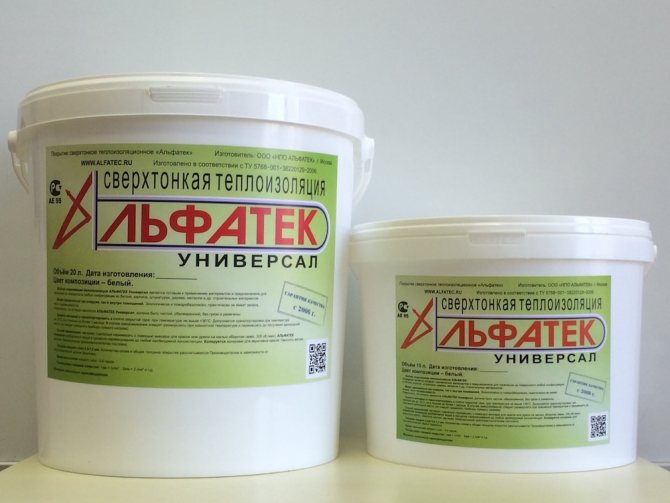

Liquid insulation
In terms of efficiency, such coatings with a thickness of 1 mm are not inferior to 50 cm of mineral wool plate heaters. At the same time, thermal conductivity decreases with the application of each subsequent layer, due to which it is not a problem to achieve the required performance.
The average liquid consumption is no more than 0.5 liters per square meter. Despite the high cost, this method of insulation is economical, since the use of additional materials or special equipment is not required.
The main advantages of liquid insulation are:
- ease of application on surfaces of any complexity;
- simplicity in operation;
- long service life;
- maintaining the tightness of the layer during multiple thermal expansion of the metal;
- the useful volume of the garage is not lost;
- no finishing layer is required.
Foam insulation
Insulating a metal garage from the inside with a foamy material is very difficult, since it requires the use of special equipment, personal protective equipment, and experience in carrying out such work. It consists in applying polyurethane foam to the prepared surface, which, when in contact with air, hardens and forms a sealed layer.
This material has high adhesion to metal, so it easily fits onto surfaces with any geometry. It is able to increase the strength and rigidity of the structure even with a layer thickness of 30-40 mm. In terms of efficiency, it is slightly better than mineral wool insulation - for comparison, 40 mm of polyurethane foam correspond to 50 mm of mineral wool in terms of thermal conductivity.
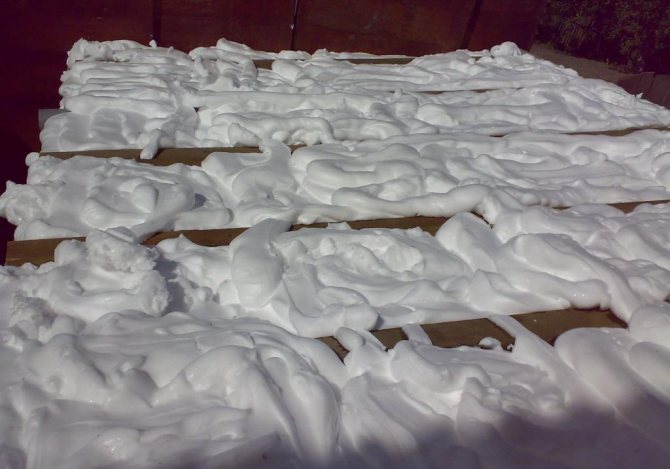

Foam insulation
Installation requires the installation of a batten and mandatory outer cladding. No waterproofing layers are required. The loads on the supporting structures are minimal.
Insulation boards of various strengths
Heaters with different strengths include foam and polystyrene plates. They have different densities, due to which it is not particularly difficult to choose the optimal insulation in terms of weight and thickness.
Insulation of an iron garage with polystyrene or polystyrene foam is performed on a flat and solid surface, free from chemically active substances and dirt. Fastening is carried out on a glue base or on liquid nails. Sometimes foil is used simultaneously with foam in order to reduce heat losses.
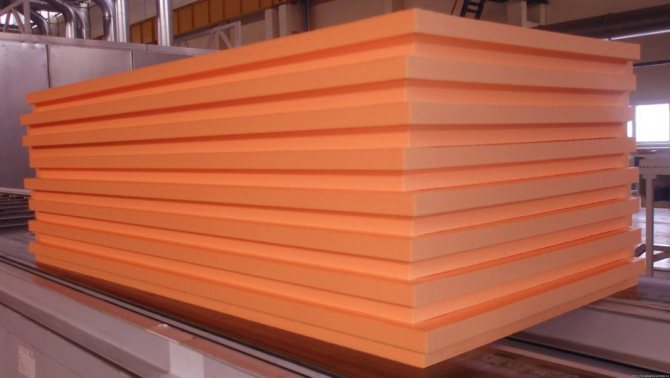

Penoplex is one of the possible heaters for a metal garage
The advantages of the materials are high moisture resistance and a minimum coefficient of thermal conductivity. The service life is over 50 years.
Fibrous materials
Mineral wool boards or rolls are used as fibrous materials. They can be easily installed even on uneven surfaces, resistant to biological and chemical influences, and have high tensile strength.
Do-it-yourself insulation of an iron garage with mineral wool requires the mandatory installation of guides, which will allow not only to strengthen the walls, but also to create a basis for sheathing with wood or plywood sheets. In this case, it is necessary to find the best option for the thickness of the material, since the useful area of the room is lost.
The benefits of using fiber boards are:
- excellent level of sound insulation;
- increased fire safety;
- ease of styling.
The disadvantage of mineral wool is its hygroscopicity - as a result of the accumulation of moisture, it loses its insulating properties.
Insulation of the ceiling in a metal garage
Solving the problem of how to insulate an iron garage, you should definitely take care of the thermal insulation of the ceiling. It needs to be insulated not only from the inside, but also from the outside. Only then will it be possible to obtain the desired effect. If the outside of a metal garage is traditionally insulated with paint, then there are several ways to work from the inside:
- multi-layer painting of the ceiling with a heat-insulating agent;
- spraying a liquid heat insulator;
- the use of mineral wool or expanded polystyrene plates.
Having chosen the latter option, as the cheapest, the slabs should be fixed with bitumen mastic. When using expanded polystyrene, you will additionally have to treat the seams with some kind of sealant. When using mineral wool, remember that it absorbs moisture, so you need to protect its layer with waterproofing.
With a roof rafter system, its insulation depends entirely on the design. When there is sufficient clearance between the rafters, the insulator plates should be mounted between them and the waterproofing secured from above. It is advisable to perform such work at the construction stage - it is easier and better to insulate the room this way.
If the step between the rafters is small, you should lay insulation under them. When there is an attic, it is most practical to fill it with expanded clay, and then lay a waterproofing material on top. The final stage of such insulation is the filling of a cement screed. However, high-quality thermal insulation of the interior will not be achieved by this - it is also necessary to carry out internal work. It all depends only on the material that will be used:
- Foil-clad polyethylene should be fixed with slats directly to the ceiling. Such material perfectly repels moisture. To get the maximum effect, plywood or fiberboard must be nailed over the slats.
- Mineral wool. First, it is necessary to glue the waterproofing to the ceiling, then mount the lathing. In its intervals, lay mineral wool slabs, protect them with a vapor barrier film and sheathe them with cladding.
- Expanded polystyrene. Glue the tiles to the ceiling using tile adhesive. To improve thermal insulation, it is recommended to pre-glue a waterproofing sheet to the ceiling.
Garage insulation materials
We turn to the question, what is the best way to insulate an iron garage. Consider what materials are used for thermal insulation from the outside and from the inside.
Materials for outdoor insulation
It should be noted that the walls and roof of the garage are insulated in different ways using different materials. And more often than not, the roof is insulated from the inside, because the steel sheet that forms it, in this case, will serve as a roof covering.
As for the walls, there are several options. Brick cladding (in half or in whole) is considered traditional. In this case, the brick is laid under the jointing, that is, with the exact installation of each stone horizontally and vertically, with a seam thickness of no more than 8 mm. At the end of the work, the seams are leveled with a special tool - a do-it-yourself scraper or purchased in a store.
Floor insulation
Basically, we have sorted out the question of how to insulate a metal garage. It remains to consider additional options for protection from the cold. It will help to improve thermal insulation floor insulation. Since its surface is usually made of metal or concrete, we will consider options for warming these materials.
The most affordable now is to insulate the floor with foam:
- First, you need to carefully level the surface, then clean it up, removing all cavities or cracks with a putty.
- For concrete covering, it must first be primed twice.
- If there is a pit or cellar in the garage, waterproofing is required.
- Apply adhesive directly to the floor and foam plastic with a notched trowel, lay the board and press it down carefully.
- It is allowed to use special dowels, but then you will have to drill the floor.
- The floor insulation is completed with a screed. Additional strength will be provided by the addition of extruded granules to the solution.
Insulation outside
Most often, metal garages are insulated from the inside, but if the space allows, then you can do all the work outside. This will save space, especially if the garage is small.
A frame for the lathing is being erected around the garage. Polystyrene or penoplex is used as insulation. Seams are sealed with polyurethane foam. Siding is used as cladding. If the roof has a rafter system with one or two slopes, then:
- with a wide step, insulate with mineral wool between the rafters and cover it with waterproofing on top;
- with a frequent step - lay the insulation under the rafters;
- in the presence of an attic, cover the floor with expanded clay.
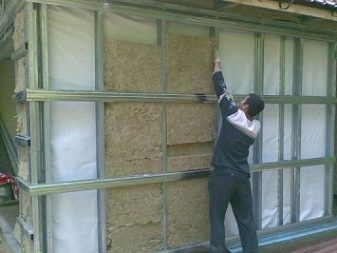

If the roof is flat, then the outside can be covered with heat-insulating paint or the ceiling can be insulated from the inside.
The method of insulation is selected based on the area and location of the garage, as well as the financial capabilities of the owner.
When calculating the estimate, all costs should be increased by 10% so that there is a supply of materials for an unforeseen event.
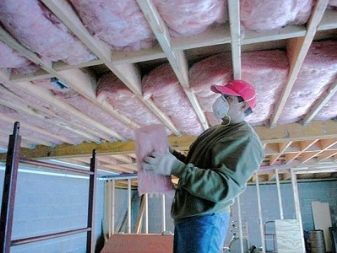

How to insulate a garage, see below.
Moisture and cold temperatures are the main enemy of the vehicle. Liquid spillage on the body and other metal elements can form rust, and severe frost can damage the engine.
For this reason, it is necessary to create such a microclimate and temperature balance in the garage in which the car will not suffer. For this, the garage is insulated.
Insulation of the garage cellar
If there is a cellar or a viewing hole, they also need to be carefully insulated.
Cellar ceiling
Before insulating the cellar ceiling, mount a waterproofing layer on it. Then you can already glue the foam to the ceiling. Liquid filler is ideal for insulation, although it is much more expensive to use.
Cellar walls
The material for wall insulation must be mold-resistant and moisture-proof. The best option is expanded polystyrene. Its slabs should be fixed to the lathing or directly to the walls. When performing insulation work, do not forget about wiring. It is required to lay it in a metal sleeve or fasten the box.
Cellar floor
Since the floor in the garage cellar is usually unpaved, it is better to fill it with bitumen. First, crushed stone should be poured, then sand, everything should be tamped and poured with bitumen on top. If the floor is reinforced concrete, it is better to cover it with roofing material over the sawdust, and then fill it with a cement screed on top.
Additional activities
The inner side of the garage walls requires special preparation, including plastering with a "warm" type of plaster or applying heat-insulating paint to the surface.
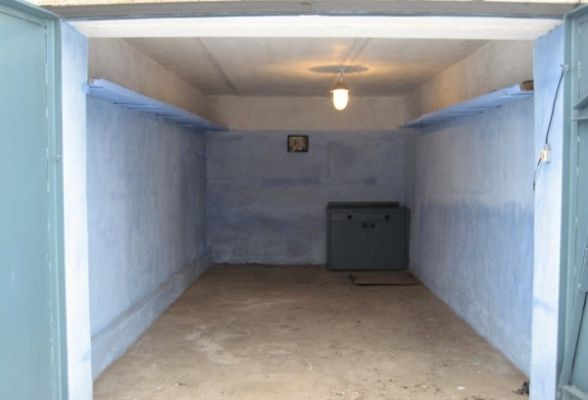

The possibility of shifting the dew point to the outside of the garage walls helps to protect them from the negative effects of freezing and excessive moisture. Experts recommend making a device for a forced ventilation system designed for a high rate of air exchange.
Application of liquid insulation
The use of liquid thermal insulation, presented in the form of paint or polyurethane foam, is among the most popular options. The variety of paints used provides a choice: thermos paint, isolate, etc.
Liquid foam, which is a foamy mass, is made directly at the construction site using the so-called. foam generator.
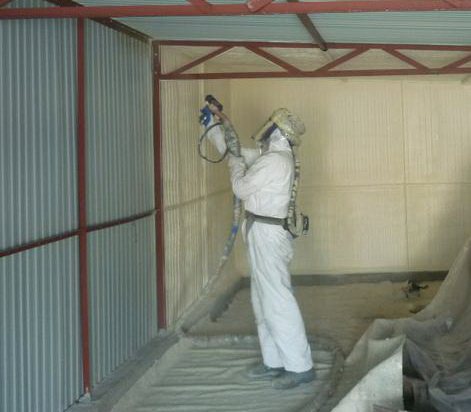

Cured foam has the appearance of a hard crust with excellent adhesion.
Fastening foam boards with glue
Fastening foam to glue is one of the easiest and most affordable ways to insulate garage walls from the inside.
When using it, it is necessary to pay increased attention to the issue of cleaning and degreasing metal surfaces.
This measure ensures reliable and durable fastening of the heat-insulating material.
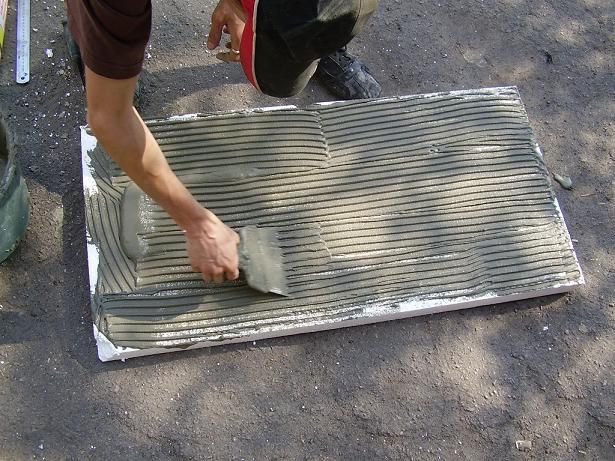

The gaps formed between the sheets are best filled with polyurethane foam. After that, paint can be applied to the surface of the insulation.
When using foam plates, it is necessary to remember about its increased ability to ignite and that a large amount of toxic substances is released during combustion.

